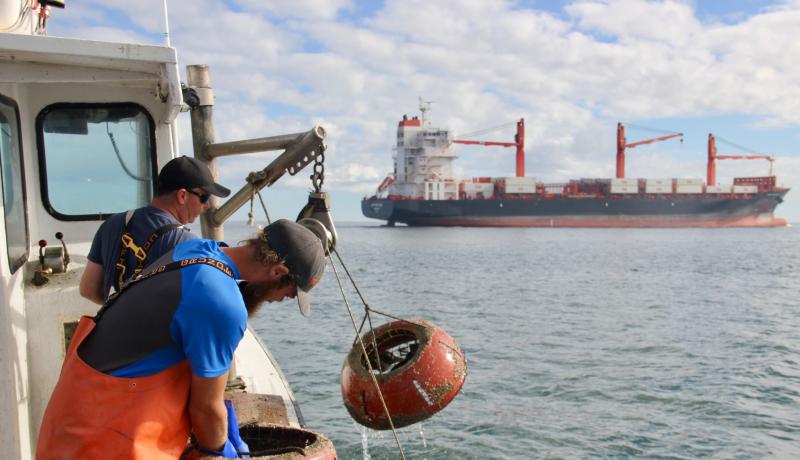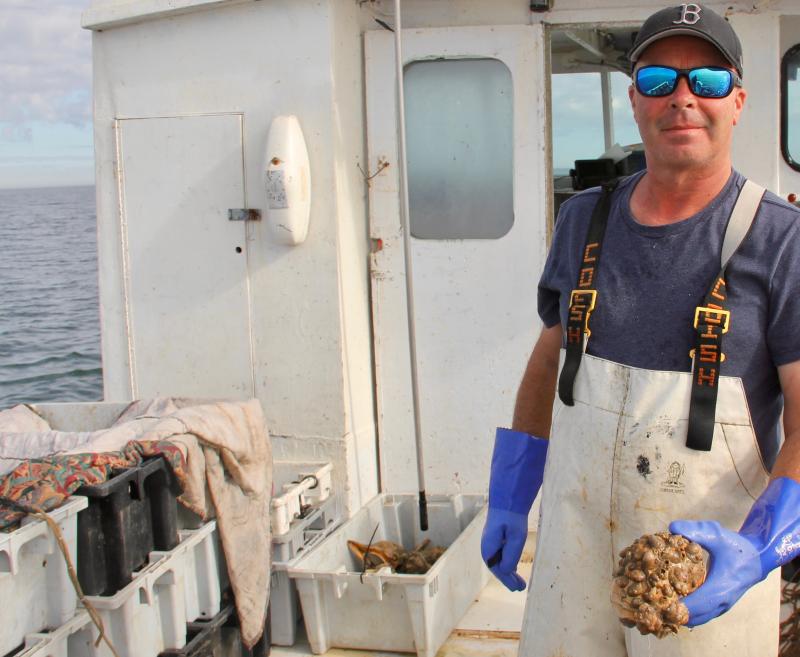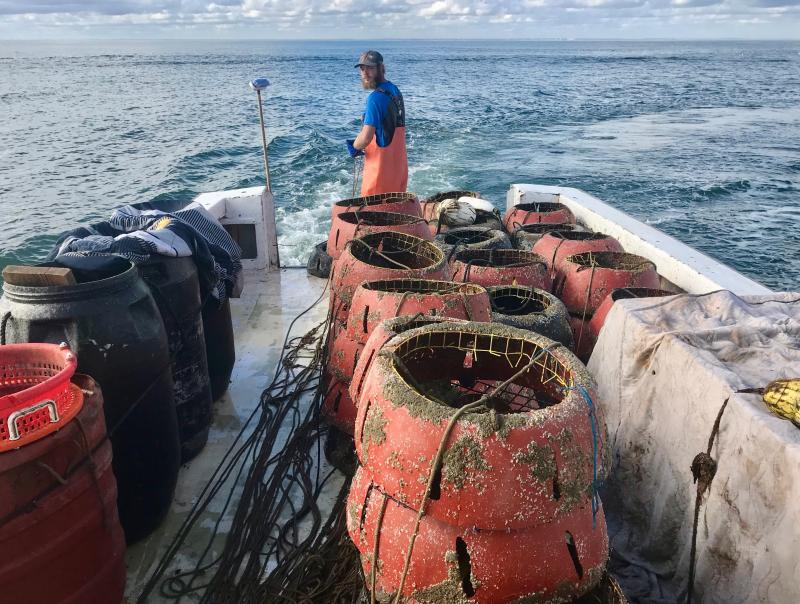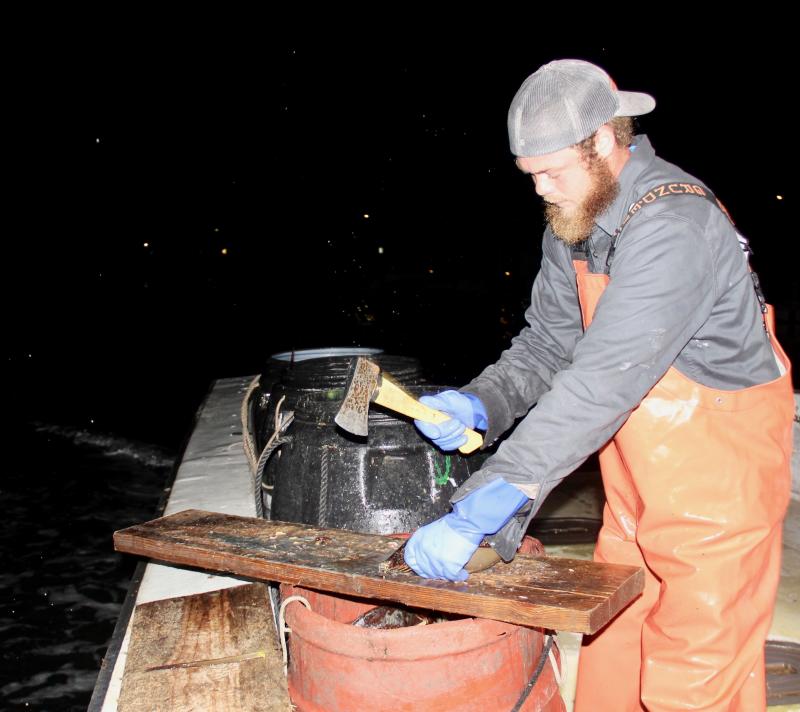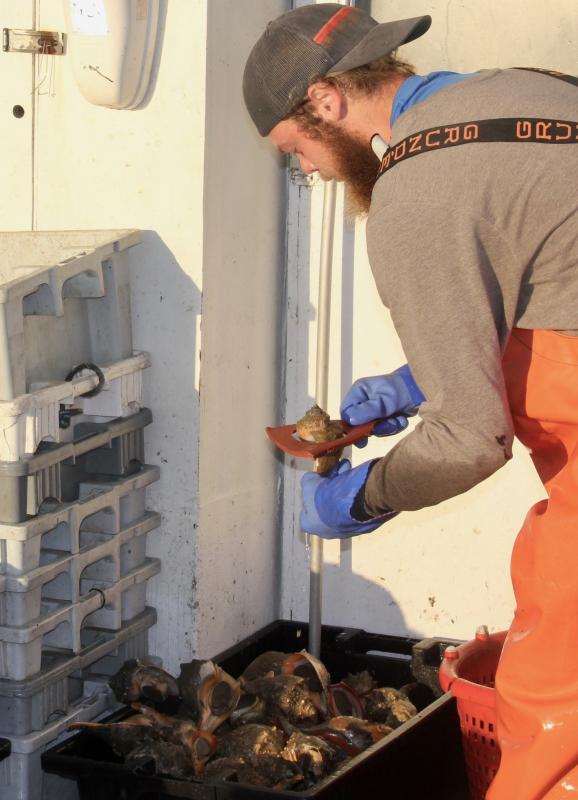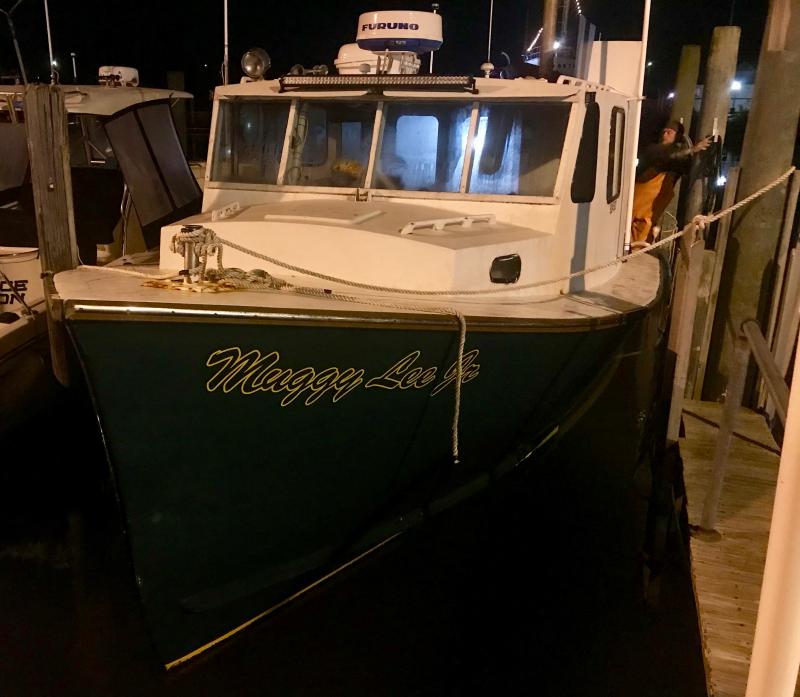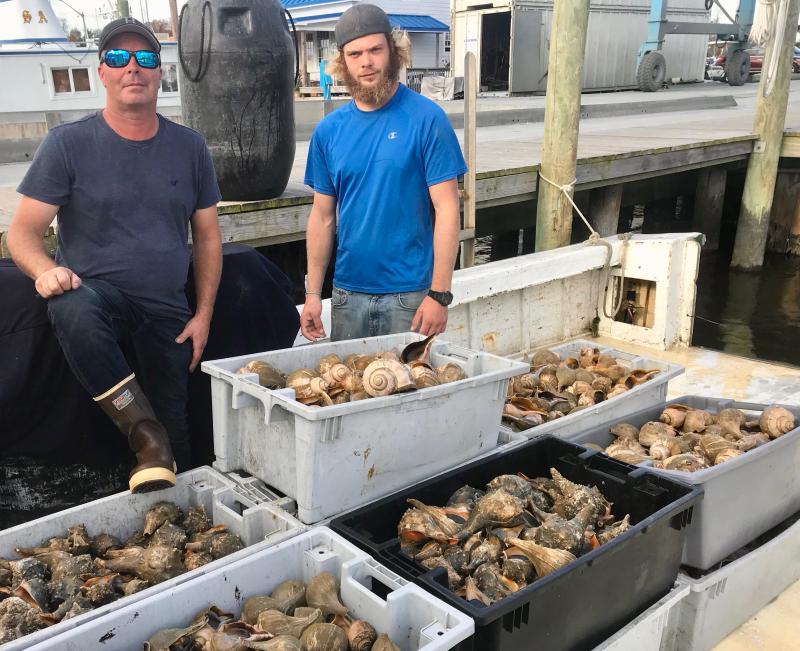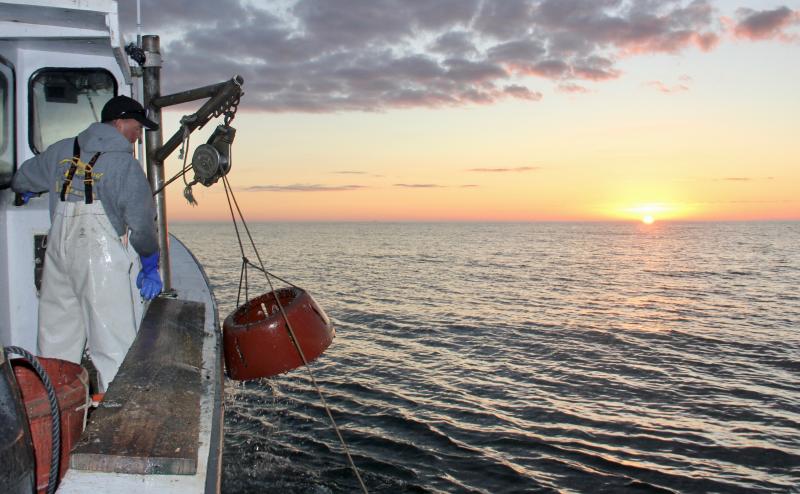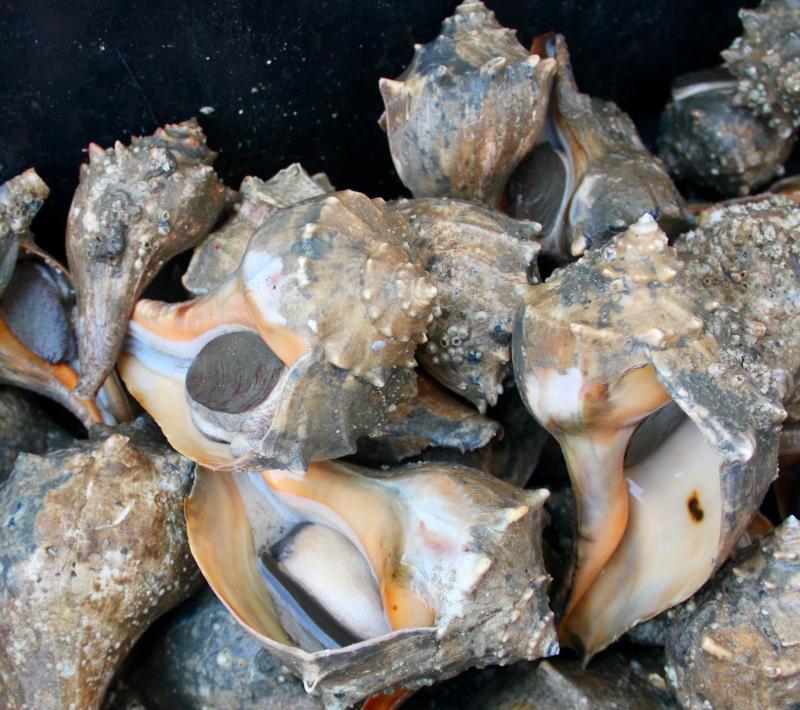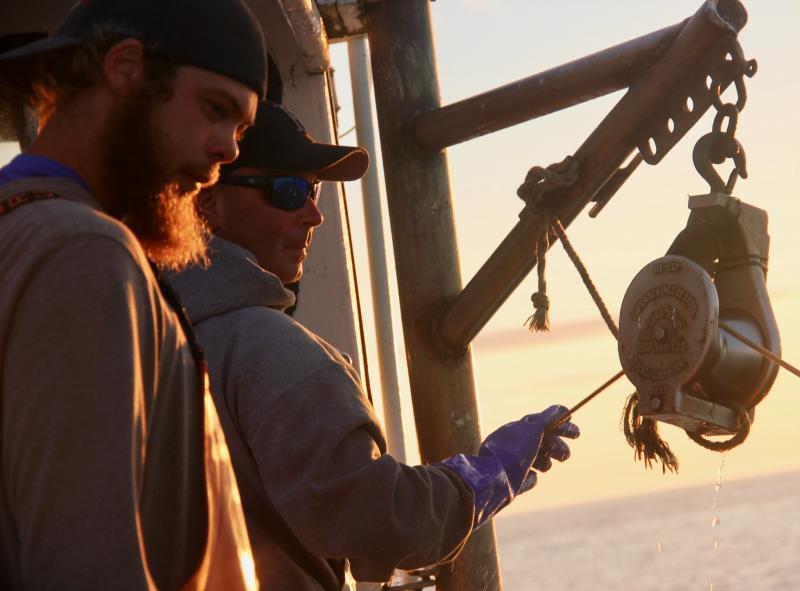Catching and selling conchs a way of life for Shawn Moore
“This is the definition of multitasking.” – Shawn Moore
It’s 8 a.m. on the sixth day of an unusually mild run of mid-November weather. Easy winds out of the south, temperatures in the 60s and 70s, the ocean calm about six miles off Rehoboth Beach.
“This is the mildest November I’ve ever seen,” says Shawn Moore as he diesels his Muggy Lee Jr. eastward toward his next 2,400-foot-long set of 30 conch pots. His entire stand includes 30 sets for a total of 900 pots in the water.
“I’ve seen about a million sunrises out here and never get tired of them. The ocean can be fickle and heartless and beautiful. Sometimes she can really beat you up, but today I’m out here catching conchs in beautiful weather. I can’t ask for anything more.”
As he talks, Moore monitors a whole array of electronic screens and two radios. One radio keeps him in touch with the shipping traffic coming and going in these entrance waters of Delaware Bay; the second is for communicating with other commercial fishermen in the area.
His radar screen shows shipping traffic in dark, fog or daylight. That helps him stay away from collisions. Freighters and tankers always win those fights.
The GPS (global positioning system) screen shows water depth, temperature and bottom contours. Shawn likes to set his rigs across troughs in the bottom where years of experience have taught him conchs congregate.
Another screen, the one Shawn watches most avidly, displays two sets of numbers along east-west and north-south axes. Those numbers help him find the buoys that mark the beginning and end of his rigs. Without those numbers, “needles in a haystack” comes to mind.
He keeps a running log of each of his 30 rigs and their locations in a simple school notebook – the stitched kind that pages won't pull out of. He records his harvests from each rig, giving a sense of where he needs to move to find more plentiful areas of the bottom-dwelling conchs. “I’ve always kept a book. Looking back, I can see what I did, and I keep it moving forward.”
The system works. Moore catches thousands of pounds of conchs each year. Roughly half of them are knobbed; the other half are smooth. Technically, they’re all whelks, each with a solid ball of meat inside that’s the size of an average fist.
Channel whelks are the smooth and more valuable variety. A Chinese buyer in New York City pays $5 a pound for the smooths. The weight includes the shell. The buyer travels to Moore’s Gravel Hill home to buy that day’s conchs and then returns to the city to sell them live the next day to Asian markets in Chinatown where they fetch $10 a pound.
The knobbed whelks bring $1 a pound. “The meat’s not as good as in the smooths, and they have thicker and heavier shells. They go to a processor in New Jersey who freezes the meats before shipping them to China.”
The markets are steady. Except when COVID-19 restrictions shut down the processors – knocking off 25 percent of the market – Moore rarely has any problem moving his catch.
A slick, complicated harvest
The harvesting process is nothing short of slick: a well-oiled and productive system that requires a shipshape deck, steady focus by captain and crew, and the ability to move – as legendary basketball coach John Wooden once said – quick but without hurry. Once the fishing begins, there’s little break in the action. A young man’s game.
Moore is 45 and has been at this for about 20 years. His crew on this day is 24-year-old Zandar Planches, who picked up the system quickly, knows what has to be done, and does it.
The crew usually involves Moore and two others. But on this day one man is taking a day off.
“In good weather like this with no breaks, it burns you out. Ten-hour days at least, starting about 4:30 a.m. We would usually fish 450 pots each day – half our stand – but today we’ll stop at 300 and get in early. We need a break.” For them, at least this time, the coming bad weather is a blessing.
With two crew, Moore stays behind the wheel inside, motors from set to set, monitors his data, records his locations and catches, and directs where and when to replace the set he’s just fished. Plenty for one man. But on this day, a man down, he also works the hydraulic pot winder, running the boat from the deck helm, keeping all the lines straight, helping to sort each catch after swinging incoming pots onto the gunnel’s sorting board.
Moore builds all of his pots out of heavy, round, plastic pickle barrels. “They don’t get eaten up by worms like the wooden ones do,” he says.
On the way out in the early morning dark from the docks in Lewes, Planches works in fluorescent LED light on the open-sterned deck using a hatchet to chop male horseshoe crabs in half for rebaiting the pots.
Pebbled concrete poured across the metal mesh bottoms of the pots sinks them squarely to the bottom when the emptied pots go back overboard. Attracted by the bait, conchs climb into the open-topped pots and drop in. A two-inch-deep circular wire grid attached just inside the round top prevents them from climbing back out.
The pots are strung on 60-70-foot-long lines that hang at 80-foot intervals along the 2,400-foot-long set. Keeping all those lines straight and untangled as the pots are wound in, emptied, rebaited, and stacked in well-organized rows so they can in turn be redeployed smoothly, is no easy task. But the men get it done, all the while culling the catch by size and species into large plastic crates – throwing the smalls back overboard – and keeping the catch wet and covered.
Temperatures affect potting
Conchs pot best when the water temperature is between 60 and 45, says Moore. When the weather's warmer, they’re not as aggressive, not as hungry. “When a cold snap comes, we can catch as many as 900 to 1,000 pounds in a day. When it’s warmer, we may catch 300 to 500 pounds. The pots need more soak time when it’s warmer.”
What surprises the Cape high graduate most about conchs is the abundance of the resource. “It's amazing how they keep producing. We can pot all year long, and while there’s a size limit – they have to be at least 3 1/8 inches in diameter at their widest part – there’s no take limit. What does limit us is the weather and the months when the conchs are active enough to make potting worthwhile.”
Moore conchs seven or eight months a year, weather permitting, but switches to crabbing with traditional crab pots in upper Delaware Bay during the warm summer months.
Looking into each pot breaking the ocean’s surface as it is reeled in by the winder is like treasure hunting to Moore.
About halfway through this day’s efforts, he takes a look at the yield from the set he has just finished. “That right there is about a $500 run. A good one. Pretty stuff. It costs me about $680 to leave the dock – bait, fuel and help. Of course that doesn't count repairs to the boat. We've paid for our trip today. Now we’re making money. Everything else we catch from here on out is profit. The more you put into this, the more you get out.”
Moore looks at the conchs and looks at his screens, with Muggy Lee’s 430 Cummins diesel powering loudly toward the next set. “It’s a numbers game, and it’s been good to me and my family,” he says.
“This is my world out here, away from everything. I don’t want to be doing anything else. I don’t know how to do anything else. I love it.”
